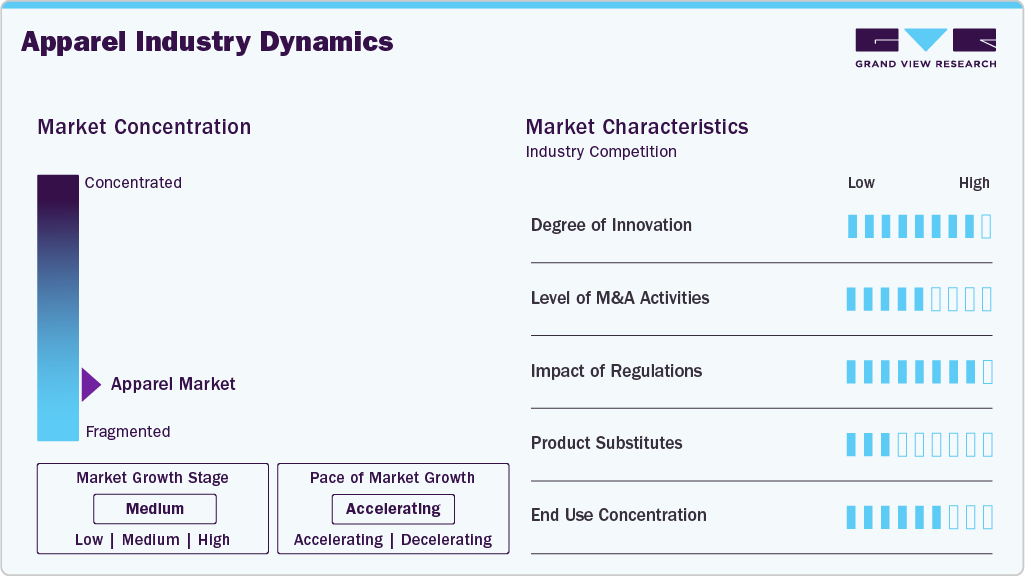The global apparel market was valued at USD 1.77 trillion in 2024 and is projected to reach USD 2.26 trillion by 2030, with a compound annual growth rate (CAGR) of 4.2% from 2025 to 2030. This growth is primarily driven by increasing consumer spending on apparel worldwide.
According to the U.S. Bureau of Labor Statistics, in 2023, the average annual household expenditure for women’s apparel was approximately USD 655, while for men’s apparel it was USD 406. The expanding availability of products through online distribution, the growing penetration of e-commerce platforms, and a diverse range of collections launched by key market players are expected to further fuel growth during the forecast period.
Furthermore, rising disposable incomes in emerging markets are significantly contributing to the growth of the global apparel market. Countries like China, India, and Brazil are undergoing rapid urbanization and economic development, strengthening the middle class and enhancing purchasing power. This demographic shift is increasing demand for clothing and accessories as consumers seek to update their wardrobes, follow fashion trends, and improve their lifestyles.
There is also an increasing preference among consumers for sustainable and environmentally friendly apparel, which is likely to influence market growth. Consumers are becoming more aware of the environmental impacts of their consumption habits and the materials used in production. As a result, they are actively searching for clothing that is sustainably and ethically produced, favoring eco-friendly materials such as organic cotton and recycled fabrics. There is a growing demand for brands to adopt transparent supply chains, minimize waste, and ensure fair labor practices. Embracing sustainable practices is essential for both individuals and businesses to reduce their environmental footprint and promote a more sustainable future.
Key Market Trends & Insights
- Regional Performance: The Asia Pacific region dominated the global market with a revenue share of 40.5% in 2024. This leadership is driven by the increasing penetration of e-commerce, a heightened focus among fashion brands on improving their digital presence, and a growing preference among young consumers for the latest fashion trends.
- S. Market Share: The U.S. held the largest revenue share of the regional market in 2024, bolstered by the presence of major companies, rising disposable incomes among young consumers, an influx of new entrants, and technological advancements that enhance production, design, and distribution capabilities.
- Market Segment: The mass apparel segment led the global market with a revenue share of 68.0% in 2024. This segment continually introduces new designs and patterns that engage customers, prompting retailers to replace inventory with the latest arrivals rather than restocking older items.
- End Use Segment: The women’s segment captured the largest revenue share in 2024, reflecting a surge in demand for new trends and diverse options. Women's fashion is in higher demand than men's, driven by a wide variety available, including dresses, skirts, blouses, and accessories, leading designers and retailers to prioritize offerings in this segment.
- Distribution Channel: The offline segment accounted for the largest revenue share in 2024. Offline shopping offers a personalized experience, allowing customers to assess product features such as fabric quality and design. Store associates can provide tailored assistance, styling advice, and effectively address customer inquiries.
Order a free sample PDF of the Apparel Market Intelligence Study, published by Grand View Research.
Market Size & Forecast
- 2024 Market Size: USD 1.77 Trillion
- 2030 Projected Market Size: USD 2.26 Trillion
- CAGR (2025-2030): 4.2%
- Asia Pacific: Largest market in 2024
Key Companies & Market Share Insights
Key players in the apparel industry include Adidas AG, Puma SE, VF Corporation, Burberry Group plc, and Nike Inc. These major companies are adopting strategies such as new product development, innovation, collaboration, and efficient marketing and distribution.
- Burberry Group plc: A luxury apparel brand known for its diverse product range, including outerwear and scarves, operating across the Asia Pacific, Europe, the Middle East, Africa, and the Americas.
- Adidas AG: Offers a wide variety of apparel, including sportswear and athleisure, catering to global sports enthusiasts with specialized collections.
Key Players
- VF Corporation
- Burberry Group plc
- Puma SE
- Adidas AG
- NIKE Inc.
- H & M Hennes & Mauritz AB
- LVMH
- KERING
- PVH Corp.
- INDITEX
Explore Horizon Databook – The world's most expansive market intelligence platform developed by Grand View Research.
Conclusion
The apparel market is poised for significant growth, driven by increasing consumer spending, evolving fashion trends, and a heightened focus on sustainability. With the rise of e-commerce and the demand for diverse clothing options, the market is well-positioned for continued expansion. As consumer preferences increasingly shift towards sustainable practices, brands that prioritize ethical production and transparency will likely gain a competitive advantage in this dynamic industry.







